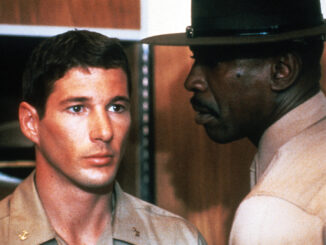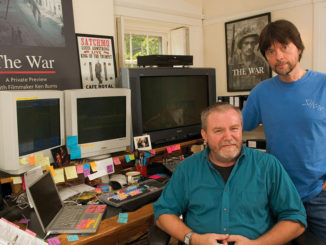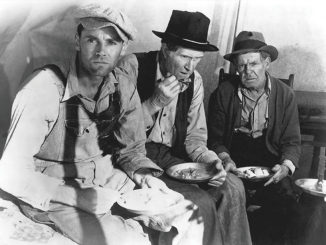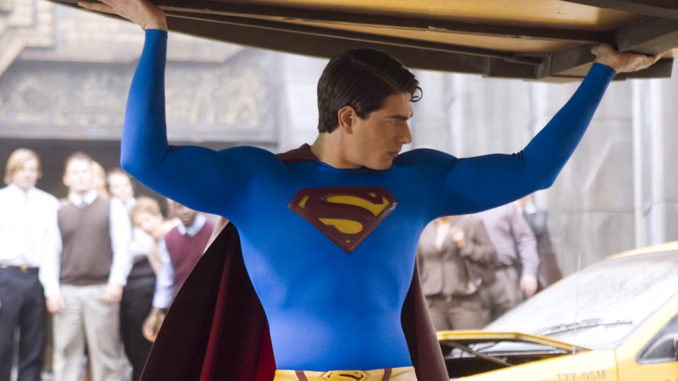
by Robin Rowe
Superman was the very first superhero––before Batman, Spider-Man and even Captain Marvel––when he debuted in Action Comics No. 1 (1938). The new Warner Bros. epic action-adventure feature film Superman Returns presents some firsts of its own, too. No other feature film has ever been shot with digital Panavision Genesis cameras, nor used a daunting dozen Avid systems in post-production.
It took 19 years for Superman to return to cinema screens (after the forgotten Superman IV: The Quest for Peace in 1987), a saga that could be a story in itself. “An idea I’ve always had was telling a ‘returns’ story,” says director Bryan Singer. “I wanted to take it forward, not retell stories.” Singer, whose directing credits include The Usual Suspects, X-Men and X2, worked with the latter film’s writers, Dan Harris and Michael Dougherty, to create a fresh story about the man from Krypton. Warners asked Singer to postpone his project Logan’s Run, which was in pre-production, in order to first work on Superman Returns, which was shot in Sydney, Australia over a 140-day period.
Editing and Scoring Superman
The film has two editors, John Ottman, who also composed the score for Superman Returns, and Elliot Graham. “When editing, I’ve got to be there during shooting,” says editor Ottman, who has cut and scored most of Singer’s films, as well as his own directorial effort, Urban Legends: Final Cut. “I was there from about an hour after shooting starts until done, a 10-to-14-hour day. There’s a lot of footage.” Ottman explains that pacing is an unpredictable formula. “A scene may be a good one, but if it’s superfluous, it could drag great scenes that follow, creating a lag that’s hard to recover from,” he says. “When editing any scene, only a couple approaches are viable. I always edit to the actors’ performances. If you don’t believe the character, you’re not going to believe the scene.”
Although having 12 Avids is spectacular, there’s one quirk of the systems that slowed down production. To edit a portion of a scene into another scene that has dissolves or an audio fade, the edit fails with the error message: “Cannot split transition effect.” If either the in or out point on the source side sequence is within a transition (in video or audio), that selected region cannot be edited into another sequence. The film’s editors lost time by undoing the transitions to work around this limitation. “I wanted to make a t-shirt that said, “Just split my goddamned transition effect, Please!” Ottman says. This obstacle is a known issue for which Avid is still seeking a solution.
Because visual effects today are mostly done with computers, shooting digitally can be a tremendous time-saver for effects shots.
Ottman’s first cut of Superman Returns was three hours long. He then cut 30 minutes from the story. After the first cut, he faced a mammoth task with the score. For composing, Ottman uses a Macintosh program called Digital Performer, integrated MIDI and audio sequencer software designed for studio recording, film scoring, live performance and remixing. “In the old days, you would just tinkle on the piano and say, ‘Imagine an orchestra,’” says Ottman. “Now, you write every part down to the last flute trill. It’s very labor-intensive.” The process is to write, orchestrate, arrange and render.
The editor/composer enjoys doing temporary effects and sound design in editing. “I use the pitch tool a lot in Avid to modify sound effects,” he says. “I hate it when movies have the same sounds from stock, like ‘Door Closing No. 17.’ Using pitch up or down, plus other EQ and reverb tools, makes the sound original. How can anyone use that sound verbatim?”
Ottman’s temp sounds often end up in the final edit. When he needed to create the sound of Superman’s nemesis, Lex Luthor’s night vision device, “I wanted a high-pitch whistle,” says Ottman. “So I pitched the whistle up to be a sound only a dog can hear.”
Working as an Editorial Team
“Today, the technology has climbed to the point where we can present comic book characters doing the things they were once only able to achieve in a comic book,” explains Graham, who previously worked with Ottman editing X2 and also cut the pilot episode of Singer’s television medical drama House and The Greatest Game Ever Played. “Digital enables Superman to do more dynamic things with flying and fighting.”
“When editing any scene, only a couple approaches are viable. I always edit to the actors’ performances. If you don’t believe the character, you’re not going to believe the scene.” – John Ottman
Sony Pictures Imageworks had expertise with flying superheroes from the two Spider-Man movies, but Superman would be more difficult; he doesn’t wear a mask. The digital Superman does things that can’t be done realistically with an actor on wires. In Superman Returns, the digital double appears in wide, medium and even a couple of close-ups, where the image pushes in from a very wide angle of the character accomplishing something incredible. “Once he’s digital, you have to pretty much stay digital,” notes Graham.
“Ninety-nine percent of Superman Returns was shot on the new fully digital Genesis camera,” he continues. “Whether a movie is shot digitally or on film, it’s still about looking at images and telling a story. That hasn’t changed.” Graham still showed up in the morning with a bin of dailies waiting for him to look through and cut. “It was lots of fun to cut the air disaster scene,” he says. It was a huge process: integrating a digital plane, the digital Superman, the real Superman [actor Brandon Routh] and practical stunts involving people flying around inside the plane––all intercut with mission control and people on the streets of Metropolis.”
For Graham, “Editing is an instinctual process where you create moments of life.” The film moves between spectacle and intimate, character-driven moments such as a scene with Lois Lane and her fiancé discussing the fact that Superman has returned and what it means for them. “I love finding all those little moments that create characters and stories and bring them alive,” adds Graham.
Managing the Edit Process
“Superman Returns was the first feature shot on the Genesis cameras, did in-house, high-resolution scans and conforms, and provided early digital intermediate (DI) grading of scenes,” says first assistant editor Liza Espinas-Regnier. She joined the film after being referred by visual effects editor Derrick Mitchell (with whom she worked on I, Robot), who was on X2 with Ottman and Graham.
“The one thing I did on Superman Returns that people probably think is crazy was to have color-corrected dailies,” – Newton Thomas Sigel
Espinas-Regnier ran the cutting room and assisted both editors with whatever they needed––be it laying in sound effects, cutting in visual effects shots, helping with scenes, finding music or cleaning dialogue tracks. “Picture editorial is the hub of post-production,” she explains. “Every other department needs something from us in order to do its work––whether it’s sound, music, visual effects, marketing, IMAX, TV spots, the conform, DI and so on.
“We shot the equivalent of 1.5 million feet of film with ten Genesis cameras, two Sony 950s and six to eight 35mm cameras,” she continues. “Some days, I’d have four units shooting: main, second, visual effects and visual effects miniatures. I keep separate logs of each unit’s script supervisors’ reports to manage and organize all the material coming in.” For big scenes, she organized bins by scene number in the Avid.
Espinas-Regnier had 10 Avids on I, Robot. But Superman Returns required more. “We had 11 Avids and, for a short period of time, one Nitris Symphony [v.1.01] for a total of 12,” she says. “We’re working on Meridians with Media Composer v.11.2.6. When setting up the show, I chose Meridians over Adrenalines because they’d proven to be a stable platform and, as a first assistant, I wanted to make sure we were using the most dependable tools to get the job done.”
The huge editing team (see accompanying story on the assistants) was on a Unity Media Network with 3.5 Tb of storage. “Three of our Avids were on the mixing stage [one each for both editors, one for Espinas-Regnier and one for assistant editor Dylan Firshein],” she says. “We had mirrored Unities in both cutting rooms and were constantly passing bins and media back and forth via secured servers to keep the projects in sync.” The projects got so big so fast that to prevent them from getting too sluggish, she regularly cleaned and archived old bins and reels, which she stored on the Unity for easy access.
“Editing is an instinctual process where you create moments of life.” – Elliot Graham
“One major difference with Superman Returns versus other films I’d been on is the amount of projects we had for one movie,” says Espinas-Regnier. “We had one Unity Shared Project for picture and visual effects, but both John and Elliot worked on their own individual local projects, and the two trailer editors also worked on local projects for a total of five projects.
“With the amount of people accessing the media at the same time and the amount of media created daily, there’s a lot of media management involved,” she continues. “I kept a drive log where I managed and tracked the media of each workspace and drive group and, because we used Mac OS 9, I was very diligent about keeping each user folder, and subsequent sub-folders, under the OS 9 system limit of 1,200 files per folder.” OS X has no hard limit, allowing other films use 2,000 to 3,000 files per folder. Media was backed up onto Firewire drives. These drives were then used to copy the media onto a second Unity, which was done three times: when the production moved from Sydney to Los Angeles, when it moved back to Sydney for additional shooting, back to Los Angeles for additional shooting and finally on the mix stage.
“Although we didn’t have printed dailies, there was still a telecine process,” says Espinas-Regnier. After shooting, an HDCAM SR copy was made of each Genesis original. Selected takes were graded, then transferred to a new dailies master (also on HDCAM SR) that was used for screenings and the down-conversion to DigiBetas for the Avid.
“Unlike most shows where you have one set of timecode, we had to maintain and track two sets of timecodes––the original 24p Genesis timecode and the source timecode of the dailies’ graded master,” explains Espinas-Regnier. “We received our dailies on drives like any other show. We had to check sync, re-sync when needed, check burn-ins against the flex files and so forth.” She had no SR deck to check the 24p original timecode and had to rely on the burn-ins and flex files being accurate. Any time she found a discrepancy, she’d call the telecine house and ask someone to load the tape and wind to where the slates hit in order to confirm that timecode with the timecode of the burn-in in the editorial team’s Avids.
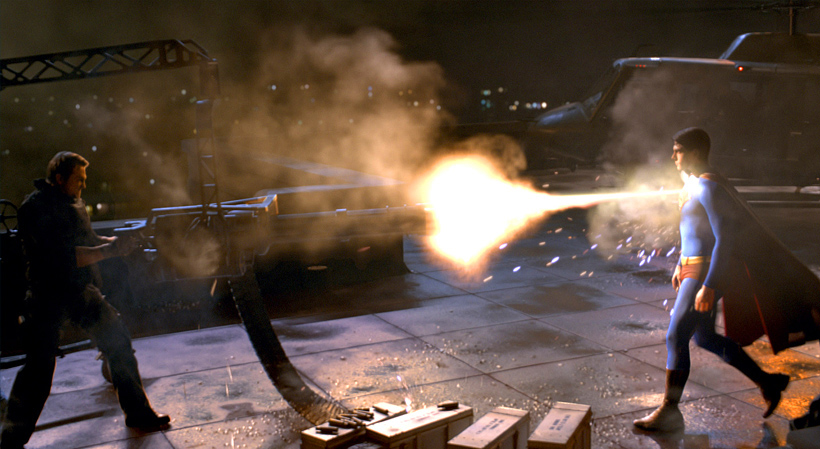
Production Meets Post
“From an editorial standpoint, it’s all about handling the media,” says visual effects supervisor Mark Stetson about using the Genesis digital camera. “Timecode and image tracking have to fall into a new paradigm.” With over 1,500 effects shots, “We touched about two-thirds of the shots in the movie,” he claims. “We had three or four Avids just for visual effects.”
Because visual effects today are mostly done with computers, shooting digitally can be a tremendous time-saver for effects shots. Panavision Genesis was chosen for Superman Returns because it was better, cheaper, and faster than 35mm film and looks more like 70mm. Color grading the Genesis footage during dailies, not in post as is traditional with film, enabled the director to see what the finished image would look like. “The one thing I did on Superman Returns that people probably think is crazy was to have color-corrected dailies,” says director of photography Newton Thomas Sigel. “I wanted Bryan to see the results in the cutting room so that he was comfortable and accustomed to what I was doing.”
A super-heroic feat in digital filmmaking, this latest film in the Superman saga utilized tools normally reserved for post-production to create the look for the film during production. Superman Returns to theatres across the country June 28.


